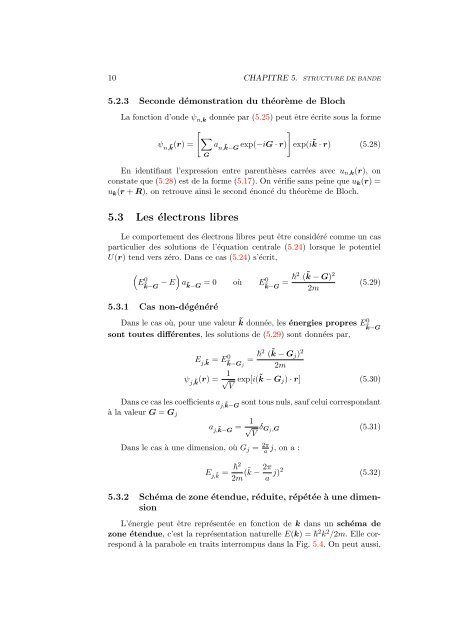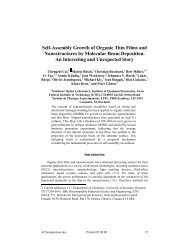Les électrons dans un potentiel périodique. Structure de bande - EPFL
Les électrons dans un potentiel périodique. Structure de bande - EPFL
Les électrons dans un potentiel périodique. Structure de bande - EPFL
You also want an ePaper? Increase the reach of your titles
YUMPU automatically turns print PDFs into web optimized ePapers that Google loves.
10 CHAPITRE 5. STRUCTURE DE BANDE<br />
5.2.3 Secon<strong>de</strong> démonstration du théorème <strong>de</strong> Bloch<br />
La fonction d’on<strong>de</strong> ψ n,k donnée par (5.25) peut être écrite sous la forme<br />
ψn,˜k (r) =<br />
<br />
G<br />
an,˜k−G exp(−iG · r)<br />
<br />
exp(i˜k · r) (5.28)<br />
En i<strong>de</strong>ntifiant l’expression entre parenthèses carrées avec <strong>un</strong>,k(r), on<br />
constate que (5.28) est <strong>de</strong> la forme (5.17). On vérifie sans peine que uk(r) =<br />
uk(r + R), on retrouve ainsi le second énoncé du théorème <strong>de</strong> Bloch.<br />
5.3 <strong>Les</strong> <strong>électrons</strong> libres<br />
Le comportement <strong>de</strong>s <strong>électrons</strong> libres peut être considéré comme <strong>un</strong> cas<br />
particulier <strong>de</strong>s solutions <strong>de</strong> l’équation centrale (5.24) lorsque le <strong>potentiel</strong><br />
U(r) tend vers zéro. Dans ce cas (5.24) s’écrit,<br />
<br />
E 0 <br />
˜k−G<br />
− E a˜k−G = 0 où E0 ˜k−G = 2 ( ˜ k − G) 2<br />
2m<br />
5.3.1 Cas non-dégénéré<br />
(5.29)<br />
Dans le cas où, pour <strong>un</strong>e valeur ˜ k donnée, les énergies propres E 0 ˜k−G<br />
sont toutes différentes, les solutions <strong>de</strong> (5.29) sont données par,<br />
Ej,˜k = E0 k−Gj<br />
˜ = 2 ( ˜ k − Gj) 2<br />
2m<br />
ψj, k ˜(r) = 1<br />
√ exp[i(˜k − Gj) · r]<br />
V<br />
(5.30)<br />
Dans ce cas les coefficients aj, k−G ˜ sont tous nuls, sauf celui correspondant<br />
à la valeur G = Gj<br />
aj, k−G ˜ = 1<br />
√ δGj,G<br />
(5.31)<br />
V<br />
Dans le cas à <strong>un</strong>e dimension, où Gj = 2π<br />
a j, on a :<br />
E j, ˜ k = 2<br />
2m (˜ k − 2π<br />
a j)2<br />
(5.32)<br />
5.3.2 Schéma <strong>de</strong> zone étendue, réduite, répétée à <strong>un</strong>e dimension<br />
L’énergie peut être représentée en fonction <strong>de</strong> k <strong>dans</strong> <strong>un</strong> schéma <strong>de</strong><br />
zone étendue, c’est la représentation naturelle E(k) = 2 k 2 /2m. Elle correspond<br />
à la parabole en traits interrompus <strong>dans</strong> la Fig. 5.4. On peut aussi,



